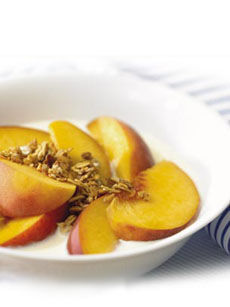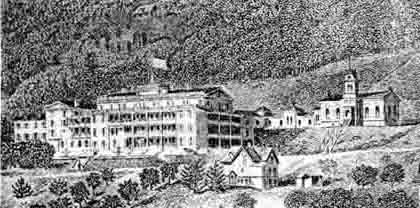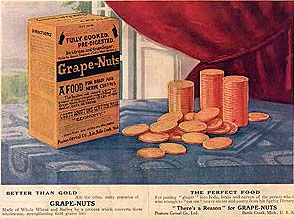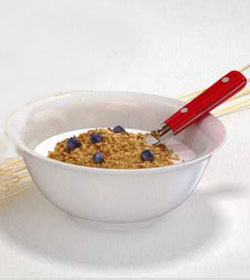

A bowl of granola and fresh fruit, no coffee or tea: That’s what Dr. James Caleb Jackson, inventor of granola, prescribed as a healthy American breakfast. Photo courtesy of EatCaliforniaFruit.com.
|
KAREN HOCHMAN is Editorial Director of THE NIBBLE.
|
|
July 2009 |
 |
Granola Girl
Gourmet Granola Cereal In Cranberry Almond & Maple Pecan
Page 1: The History Of Granola
Granola was invented by an upstate New York doctor as a health food. Then called Granula, it was the first manufactured cold breakfast cereal in the world. The idea and name were purloined by Dr. John Kellogg, who, under threat of lawsuit, changed the name of his product to Granola. Kellogg’s business-savvy brother, William Kellogg, founded the cereal company and made the big bucks while his brother, focused on medicine, went on to invent Corn Flakes and much more. This is Page 1 of a three-page article. Click on the black links below to visit other pages.
Overview
Like any favorite food—cheesecake, salsa, potato salad—everyone has his or her own idea of what granola should taste like. As with any recipe, there are as many variations as there are individuals and companies who make it. Each cook—and each eater—has his or her own point of view.
Our view is that granola isn’t trail mix or candy, but should taste healthy and whole grain—like the rolled oats cereal from which it is made (see more about whole grain cereal). Add to that some honey or agave sweetener—but not too much—spices such as cinnamon or nutmeg, and any inclusions, usually nuts and/or dried fruits. Otherwise, Dr. James Caleb Jackson, who invented granola as a health food, just might come back to haunt your dreams.
The Difference Between Granola And Muesli
Both granola, which is baked, and muesli, which is uncooked, were invented by doctors at sanatoriums—muesli in Switzerland and Granula (later copied and called Granola) in upstate New York. Granula was the world’s first dry, manufactured breakfast cereal. Whole grain Granula was invented in Dansville, New York, by Dr. James Caleb Jackson, in 1863. (See also the history of muesli.)
Dr. James Caleb Jackson, Inventor Of Granula:
The First Dry/Cold Breakfast Cereal
A fascinating fellow, Jackson (1811-1895) was born in Manlius, New York, in Onondaga County. He was educated at the Chittenango Polytechnic Institute and worked as a farmer until the age of 27. An active abolitionist, he then moved into journalism as co-owner and manager of an abolitionist newspaper, the Albany Patriot.
Jackson managed and wrote for the paper until the age of 36, when health problems forced him to retire. But after taking a “water cure” at a spa, he was rejuvenated and spent the second half of his life as an advocate for hydropathy. He received a medical education and opened his own hydropathic institute (water therapy spa) in 1847. He later took over the Our Home Hygienic Institute in Dansville, built on the site of a therapeutic mineral spring. Under Jackson’s management, the spa, renamed Our Home On The Hillside, grew to be one of the largest spas in the world, treating some 20,000 patients.

Our Home On
The Hillside:
The first building,
prior to the
1882 fire.
Image
courtesy of
Crooked Lake
Review.
Along with water cures, Jackson came to believe that diet was fundamental to improving health. Over time, he eliminated red meat, tea and coffee from the menu at the spa, and forbade his patients alcohol and tobacco. He was a staunch vegetarian, and fed his patients a near vegetarian diet that emphasized fruits, vegetables and unprocessed grains.
The First Granola: Granula
At that time, the standard American breakfast was a cholesterol-laden hot meal of  eggs, bacon, sausage and beef or chicken, plus cooked grains (hot cereal), biscuits, toast, butter and jam. It was part of the British tradition of a lavish breakfast,* to fortify the gentry for a day of sport. The less wealthy had their own chickens and a ready supply of eggs that were harvested fresh in the morning, and easy to cook. Eggs were easily accessible to city folk. In land-rich America, meat was affordable and smoked meats were convenient to keep in the larder. eggs, bacon, sausage and beef or chicken, plus cooked grains (hot cereal), biscuits, toast, butter and jam. It was part of the British tradition of a lavish breakfast,* to fortify the gentry for a day of sport. The less wealthy had their own chickens and a ready supply of eggs that were harvested fresh in the morning, and easy to cook. Eggs were easily accessible to city folk. In land-rich America, meat was affordable and smoked meats were convenient to keep in the larder.
*That also included cutlets, pink ham, fried fish, deviled kidneys, black pudding, cold grouse or pheasant, fruit and pie—dessert! See more at http://www.greatbritishkitchen.co.uk.
Jackson changed the way his charges thought of breakfast. He developed Granula from Graham flour, naming it after the granules that comprised it. It has been described as an early version of Grape-Nuts† (developed by C.W. Post in 1908—Post was a patient, and later a competitor of, Dr. John Kellogg, who helped himself to Jackson’s product concept and name—more about that on the next page).
†Grape Nuts is made from wheat and barley; it has never contained grapes or nuts. Post believed that sucrose, which he called “grape sugar,” formed during the baking process. This, combined with the nutty flavor of the cereal inspired its name, according to Post Cereals—and not the resemblance to grape seeds or grape “nuts.” Photo of Grape Nuts courtesy Post Cereals.
 Granula consisted of heavy nuggets of bran-rich Graham flour. The cereal was manufactured from a dough of Graham flour rolled into sheets and baked. The dried sheets were then broken into pieces, baked again, and broken into smaller pieces. The dense, chewy grains had to be soaked overnight in milk before serving. The manufacture of Granula was a lucrative sideline for the sanatorium. (See the history of the graham cracker and graham flour, invented by Reverend Sylvester Graham, also as a health food.) Granula consisted of heavy nuggets of bran-rich Graham flour. The cereal was manufactured from a dough of Graham flour rolled into sheets and baked. The dried sheets were then broken into pieces, baked again, and broken into smaller pieces. The dense, chewy grains had to be soaked overnight in milk before serving. The manufacture of Granula was a lucrative sideline for the sanatorium. (See the history of the graham cracker and graham flour, invented by Reverend Sylvester Graham, also as a health food.)
Photo of Grape-Nuts, said to resemble Granula,
courtesy of Post Cereals.
But all was not totally healthy in the new world of breakfast cereal. Dr. John Kellogg, a Seventh-Day Adventist whose medical career was sponsored by Ellen G. White, founder of the Seventh-Day Adventist religion (and a client of Our Home On The Hillside, where she had doubtlessly eaten Granula), created a similar product with the same name. So, Granola was born of a trademark lawsuit. Read more on the next page.
Continue To Page 2: The History Of Granola (Continued)
Go To The Article Index Above

|






 eggs, bacon, sausage and beef or chicken, plus cooked grains (hot cereal), biscuits, toast, butter and jam. It was part of the British tradition of a lavish breakfast,* to fortify the gentry for a day of sport. The less wealthy had their own chickens and a ready supply of eggs that were harvested fresh in the morning, and easy to cook. Eggs were easily accessible to city folk. In land-rich America, meat was affordable and smoked meats were convenient to keep in the larder.
eggs, bacon, sausage and beef or chicken, plus cooked grains (hot cereal), biscuits, toast, butter and jam. It was part of the British tradition of a lavish breakfast,* to fortify the gentry for a day of sport. The less wealthy had their own chickens and a ready supply of eggs that were harvested fresh in the morning, and easy to cook. Eggs were easily accessible to city folk. In land-rich America, meat was affordable and smoked meats were convenient to keep in the larder.  Granula consisted of heavy nuggets of bran-rich Graham flour. The cereal was manufactured from a dough of Graham flour rolled into sheets and baked. The dried sheets were then broken into pieces, baked again, and broken into smaller pieces. The dense, chewy grains had to be soaked overnight in milk before serving. The manufacture of Granula was a lucrative sideline for the sanatorium. (See the
Granula consisted of heavy nuggets of bran-rich Graham flour. The cereal was manufactured from a dough of Graham flour rolled into sheets and baked. The dried sheets were then broken into pieces, baked again, and broken into smaller pieces. The dense, chewy grains had to be soaked overnight in milk before serving. The manufacture of Granula was a lucrative sideline for the sanatorium. (See the